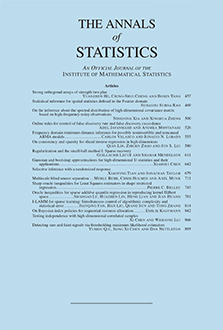Abstract
We discuss here a general approach to the calculation of the asymptotic covariance of $M$-estimates for location parameters in statistical group models when an invariant objective function is used. The calculation reduces to standard tools in group representation theory and the calculation of some constants. Only the constants depend upon the precise forms of the density or of the objective function. If the group is sufficiently large this represents a major simplification in the computation of the asymptotic covariance.
Following the approach of Chang and Tsai we define a regression model for group models and derive the asymptotic distribution of estimates in the regression model from the corresponding distribution theory for the location model. The location model is not, in general, a subcase of the regression model.
We illustrate these techniques using Stiefel manifolds.The Stiefel manifold $\mathcal{V}_{p,m}$ is the collection of $p\times m$ matrices $\mathbf{X}$ which satisfy the condition $\mathbf{X}^T \mathbf{X} = \mathbf{I}_m$ where $m \le p$. Under the assumption that $\mathbf{X}$ has a distribution proportional to $\exp(Tr(\mathbf{F}^T \mathbf{X}))$ for some $p\times m$ matrix $\mathbf{F}$ Downs (1972) gives approximations to maximum likelihood estimation of $\\mathbf{F}$. In this paper, we consider a somewhat differenct location problem: under the assumption that $\mathbf{X}$ has a distribution of the form $f(Tr(\mathbf{\theta}^T_0 \mathbf{X})$ for some $\mathbf{\theta}_0 \in \mathcal{V}_{p,m}$, we calculate the asymptotic distribution of $M$-estimates which minimize an objective function of the form $\sum_i \rho(Tr(\mathbf{\theta}^T \mathbf{X}_i))$. i i The assumptions on the form of the density and the objective function can be relaxed to a more general invariant form. In this case, the calculation of the asymptotic distribution of $\hat{\mathbf{\theta}}$ reduces to the calculation of four constants and we present consistent estimators for these constants.
Prentice (1989)introduced a regression model for Stiefel manifolds. In the Prentice model, $\mathbf{u}_1, \mathbf{u}_2, \ldots, \mathbf{u}_ n \in \mathcal{V}_{p,m}$ are fixed, $\mathbf{V}_1, \mathbf{V}_2, \ldots, \mathbf{V}_ n \in \mathcal{V}_{p,m}$ are independent random so that the distribution of $\mathbf{V}_i$ depends only upon $Tr(\mathbf{V}^T_i \mathbf{A}_2 \mathbf{u}_i \mathbf{A}^T_1$ for unknown $(\mathbf{A}_1, \mathbf{A}_2) \in SO(m) \times SO(p)$ .We discuss here M-estimation of $\mathcal{A}_1$ and $\mathcal{A}_2$ under general invariance conditions for both the density and the objective function.
Using a well-studied example on vector cardiograms we discuss the physical interpretation of the invariance assumption as well as of the parameters (A1 A2) in the Prentice regression model. In particular, A1 represents a rotation of the u’s to the V’s in a coordinate systemrelative to the u’s and A2 represents a rotation of the u’s to the V’s in a coordinate system fixed to the external world.
Citation
Ted Chang. Louis-Paul Rivest. "M-estimation for location and regression parameters in group models: A case study using Stiefel manifolds." Ann. Statist. 29 (3) 784 - 814, June 2001. https://doi.org/10.1214/aos/1009210690
Information





